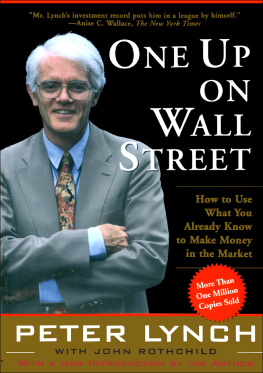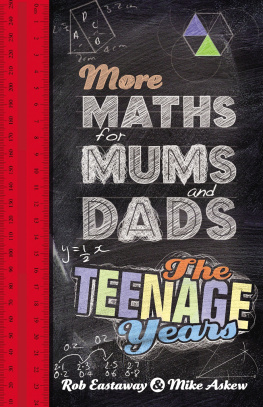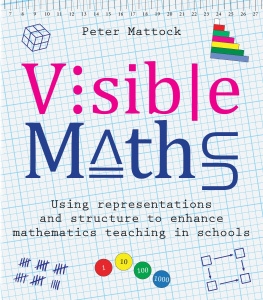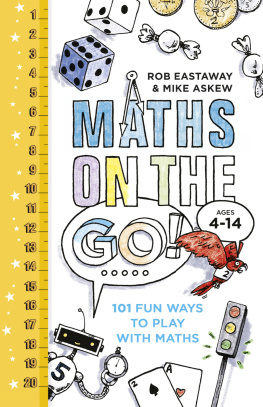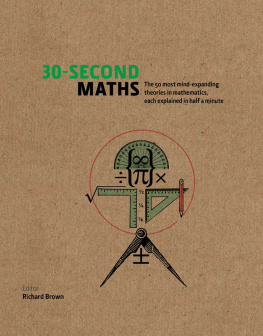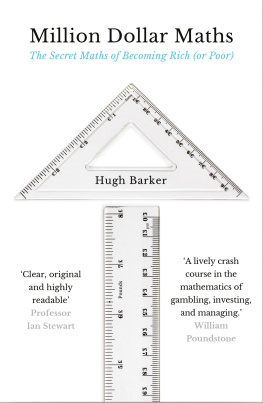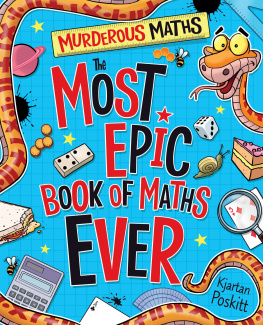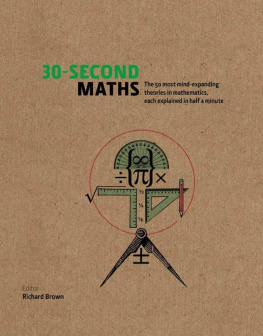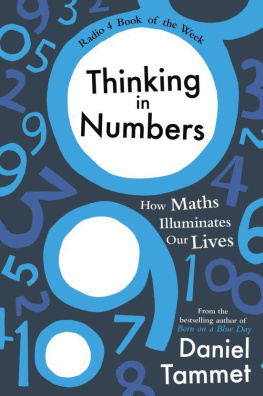CONTENTS
PREFACE
This book is a collection of articles covering all major aspects of mathematics. It is written for people who have a keen interest in science and mathematics but who may not have the technical knowledge required to study mathematical texts and journals. The articles are accessible to anyone who has studied mathematics at secondary school.
Mathematics can be enormously interesting and inspiring, but its beauty and utility are often hidden. Many of us did not enjoy mathematics at school and have negative memories of slogging away, trying to solve pointless and abstruse problems. Yet we realise that mathematics is essential for modern society and plays a key role in our economic welfare, health and recreation.
Mathematics can be demanding on the reader because it requires active mental effort. Recognising this, the present book is modular in format. Each article can be read as a self-contained unit. I have resisted the temptation to organise the articles into themes, presenting them instead in roughly the order in which they were written. Each article tells its own story, whether it is a biography of some famous mathematician, a major problem (solved or unsolved), an application of maths to technology or a cultural connection to music or the visual arts.
I have attempted to maintain a reasonably uniform mathematical level throughout the book. You may have forgotten the details of what you learned at school, but what remains should be sufficient to enable you to understand the articles. If you find a particular article abstruse or difficult to understand, just skip to the next one, which will be easier. You can always return later if you wish.
The byline of my blog, thatsmaths.com , is Beautiful, Useful and Fun. I have tried to bring out these three aspects of mathematics in the articles. Beauty can be subjective, but, as you learn more, you cannot fail to be impressed by the majesty and splendour of the intellectual creations of some of the worlds most brilliant minds. The usefulness of maths is shown by its many applications to modern technology, and its growing role in medicine, biology and the social sciences. The fun aspect will be seen in the field known as recreational mathematics, aspects of maths that no longer attract active professional research but that still hold fascination.
About half the articles have appeared in The Irish Times over the past four years. The remainder are newly written pieces and postings from thatsmaths.com . If you have a general interest in scientific matters and wish to be inspired by the beauty and power of mathematics, this book should serve you well.
INTRODUCTION
BEAUTIFUL, USEFUL AND FUN: THATS MATHS
Type a word into Google: a billion links come back in a flash. Tap a destination into your satnav: distances, times and highlights of the route appear. Get cash from an ATM, safe from prying eyes. Choose a tune from among thousands squeezed onto a tiny chip. How are these miracles of modern technology possible? What is the common basis underpinning them? The answer is mathematics.
Maths now reaches into every corner of our lives. Our technological world would be impossible without it. Electronic devices like smartphones and iPods, which we use daily, depend on the application of maths, as do computers, communications and the internet. International trade and the financial markets rely critically on secure communications, using encryption methods that spring directly from number theory, once thought to be a field of pure mathematics without useful applications.
We are living longer and healthier lives, partly due to the application of maths to medical imaging, automatic diagnosis and modelling the cardiovascular system. The pharmaceuticals that cure us and control disease are made possible through applied mathematics.Agricultural production is more efficient thanks to maths; forensic medicine and crime detection depend on it. Control and operation of air transport would be impossible without maths. Sporting records are broken by studying and modelling performance and designing equipment mathematically. Maths is everywhere.
THE LANGUAGE OF NATURE
Galileo is credited with quantifying the study of the physical world, and his philosophy is encapsulated in the oft-quoted aphorism, The Book of Nature is written in the language of mathematics. This development flourished with Isaac Newton, who unified terrestrial and celestial mechanics in a grand theory of universal gravitation, showing that the behaviour of a projectile like a cannonball and the trajectory of the moon are governed by the same dynamics.
Mechanics and astronomy were the first subjects to be mathematicised, but over the past century the influence of quantitative methods has spread to many other fields. Statistical analysis now pervades the social sciences. Computers enable us to simulate complex systems and predict their behaviour. Modern weather forecasting is an enormous arithmetical calculation, underpinned by mathematical and physical principles. With the recent untangling of the human genome, mathematical biology is a hot topic.
The mathematics that we learned at school was developed centuries ago, so it is easy to get the ideathat maths is static, frozen in the seventeenth century or fossilised since ancient Greece. In fact, the vast bulk of mathematics has emerged in the past hundred years, and the subject continues to blossom. It is a vibrant and dynamic field of study. The future health of our technological society depends on this continuing development.
While a deep understanding of advanced mathematics requires intensive study over a long period, we can appreciate some of the beauty of maths without detailed technical knowledge, just as we can enjoy music without being performers or composers. It is a goal of this book to assist readers in this appreciation. It is hoped that, through this collection of articles, you may come to realise that mathematics is beautiful, useful and fun.
THE TWO CULTURES
Of course Ive heard of Beethoven, but who is this guy Gauss?
The Two Cultures, introduced by the British scientist and novelist C. P. Snow in an influential Rede Lecture in 1959, are still relevant today.
Ludwig van Beethoven and Carl Friedrich Gauss were at the height of their creativity in the early nineteenth century. Beethovens music, often of great subtlety and intricacy, is accessible even to those of us with limited knowledge and understanding of it. Gauss, the master of mathematicians, produced results of singular genius, great utility and deep aesthetic appeal. But, althoughthe brilliance and beauty of his work is recognised and admired by experts, it is hidden from most of us, requiring much background knowledge and technical facility for a true appreciation of it.
There is a stark contrast here. There are many parallels between music and mathematics: both are concerned with structure, symmetry and pattern; but while music is accessible to all, maths presents greater obstacles. Perhaps its a left versus right brain issue. Music gets into the soul on a high-speed emotional autobahn, while maths has to follow a rational, step-by-step route. Music has instant appeal; maths takes time.
It is regrettable that public attitudes to mathematics are predominantly unsympathetic. The beauty of maths can be difficult to appreciate, and its significance in our lives is often underestimated. But mathematics is an essential thread in the fabric of modern society. We all benefit from the power of maths to model our world and facilitate technological advances. It is arguable that the work of Gauss has a greater impact on our daily lives than the magnificent creations of Beethoven.


